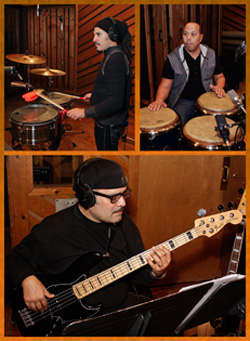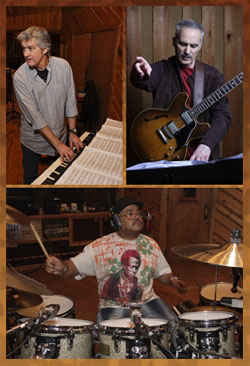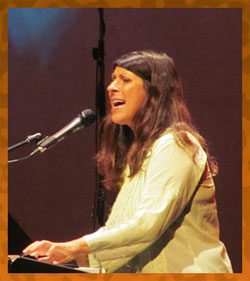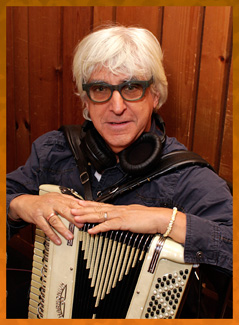

I have always believed, since I first began to buy and listen to LPs during the '60s, that an album was not just a collection of songs, but that, in some form, the artist had a particular story that he/she wanted to tell, and that that story ran from start to finish. Of course, in the LP Era, there was always an interruption in the middle, as one had to turn over the LP from side 1 to side 2. With the arrival of the CD Era, an album could finally be enjoyed non-stop from the first notes of the first tune to the final notes of the last one. Since I was lucky enough to have been granted the privilege to record in the late '70s, I have always viewed my albums in this way, and once one sits down with all the songs and tries to envision a sequence for the listener, one must ask oneself, "What am I trying to convey in this recording?" From that moment forward, you are trying to present all the music as if someone would actually sit down, in front of their stereo system, and then listen to an album from start to finish, without any interruptions. Of course, here we are, it is now 2014, and how many people in contemporary society actually sit and do that? How many people now actually own a real stereo system? Honestly, I know very few musicians who own good ones! So, where does that leave us?
In the past, the pipeline to the ears of the listener was via radio. Now, everything has completely changed, and people can access music, the music that they love in a wide variety of ways, and perhaps, radio, as we once knew it, is the least of those options. But, let's assume for an instant that people still purchase albums because they heard one song somewhere, and they really liked that one song. This was true ages ago. Of course, the artist had to hope that the one song that the listener heard actually represented the album as a whole, and represented it well. Of course, the listener has every right to like only the one song that they first heard.
 Still, an artist does not assemble and sequence the songs performed with that in mind. The artist hopes that the listener will view the album as an entity, a continuous and very personal expression conveyed through a variety of songs, each with its own mood and attitude. So, all this stated, I accept that no one will listen to this album as I would want them to, and I have decided to present this page with the songs grouped together in groups of 3 songs at a time. Maybe people can make it through 3 at a time, and then take a breather?
Still, an artist does not assemble and sequence the songs performed with that in mind. The artist hopes that the listener will view the album as an entity, a continuous and very personal expression conveyed through a variety of songs, each with its own mood and attitude. So, all this stated, I accept that no one will listen to this album as I would want them to, and I have decided to present this page with the songs grouped together in groups of 3 songs at a time. Maybe people can make it through 3 at a time, and then take a breather?Randy Brecker and I have actually known one another since the late '60s when we first met at the Lighthouse in Hermosa Beach, CA. Randy was playing with Horace Silver at the time. By a sheer twist of fate, Randy and I reconnected when I first moved to New York in 1970, and we have been bandmates at various times, and friends ever since. We keep in touch no matter what. In that spirit, as I was preparing the music for this recording, Randy and I exchanged some e-mails, and he wanted to hear what I was going to be doing. So, I sent him one of the tunes, and he kept asking to hear more. Eventually, he made me send him everything. I was so flattered when he told me that he had to be a part of the recording! How could I refuse that kind of an offer? So, I had to think about all the various pieces, melodically, and for solo space, and it wasn't long before I realized that Ornette Coleman's "Bird Food" would be the perfect vehicle. Initially, I had only conceived of the arrangement as having one solo with 3 choruses for me in an invented format, and some trading at the end between Marc Quiñones(timbal), Bobby Allende(conga), and Dennis Chambers(drums). I had to open-up another solo spot for Randy, and that would mean that we would each now play 2 choruses. The first letter [A] of Randy's solo, where mine used to be, was comprised of a little soli that I had written to serve as a 'rocket' into the actual solo. Now, Randy and I would play this together, and that's what you hear. When I bring in these pieces, and present them to a brilliant rhythm section comprised of Marc Quiñones, Bobby Allende, and Rubén Rodríguez, I might have an idea of which Latin rhythm I think will serve the tune best, but usually, things go in another direction. This time, at the rehearsals, Marc and Bobby seemed to feel that playing variations on the Caballo feel would be the best way to go. And this became the rhythmic foundation of "Bird Food."
"Blue Subtext" features a very different texture as Rob Mounsey's gorgeous keyboard sound serves as the harmonic basis of the piece. Originally conceived of as a harmonic exercise for my personal studies of the harmonies of Clare Fischer, the tune had long been a mere play-along for me used at clinics and master classes, but as this album evolved, I knew that this would be the perfect showcase for the piece. However, now I had to actually compose an original melody, because the changes had been based upon a familiar Jazz standard. Once that was done, I knew that I had to call in Rob Mounsey to interpret all the voicings that I had meticulously written out. This requires superb musicianship, a particular harmonic sensibility, and beyond that, a depth of friendship that is born of a personal and musical trust. In that regard, I am closer to Rob than to anyone else. When I asked Marc Quiñones what kind of Latin rhythm this piece would get, he quickly replied, "It's a Son!" I knew that this meant that there would be the full compliment of Latin percussion: conga, timbal, and bongo, same as you hear on "Bird Food." Because of the nature of the tune, the elements of the blues, a minor blues in large part, are always present.
Ever since I first heard "Baraka Sasa" [which is Swahili for "blessings now"] in 1974 on Freddie Hubbard's "HIGH ENERGY"(Columbia) album, it has been one of my favorite Freddie tunes. I also had the privilege of playing it with him and his group at a concert here in New York City. It came back into my mind during the preparations for the album, and it wasn't long before a concept developed. When I was putting together my demo, I used the Orisha rhythms for the Intro section. Lucky for me, Marc Quiñones agreed, and that stayed. The body of song puts to use a very swingin' variation on a Mambo rhythm, with a touch of Charanga thrown in here and there for good measure. Now I don't know why I heard it, but it always seemed to me that the sound of a berimbau would fit into this cross-cultural mix.
 Originally, I thought that the very inventive Cyro Baptista would be a part of this recording, but we couldn't get our schedules to align at the key moments. Yet, these Brazilian sounds are still there thanks to the inventive Rob Mounsey. Within the arrangement, I was able to present all of the various melodic sections that appear in Freddie's own version. This was very important to me.
Originally, I thought that the very inventive Cyro Baptista would be a part of this recording, but we couldn't get our schedules to align at the key moments. Yet, these Brazilian sounds are still there thanks to the inventive Rob Mounsey. Within the arrangement, I was able to present all of the various melodic sections that appear in Freddie's own version. This was very important to me.We now move on to the middle block of three songs. Though some might view the Afro-Cuban 6/8 feel that I employed for Wayne Shorter's beautiful song, "Infant Eyes" as not particularly special, I would disagree with that. The genesis of this particular feel comes from the tune "Curaçao" which appeared on Cal Tjader's legendary album "SOUL BURST"(1966), and featured a very polished young pianist named Chick Corea. I wanted my interpretation of this song to focus on the romantic aspects more than the insistent rhythms. To accomplish this, in part, I added some string colorations to all the [B] sections, and those colors again echo the harmonies of Clare Fischer. The ride-out of the piece brings in several elements that I would want to have as part of this tribute, and bundled-in is, of course, the element of the blues!
The middle tune in this brace of three comes from the most inventive musical mind of alto saxophonist Greg Osby. I had the great pleasure of touring Europe with Greg in a group led by drummer Terri Lyne Carrington. As part of the repertoire we played two of Greg's tunes that, for me, were unforgettable. They were "Concepticus in 'C'" and "Heard." It was one of the easiest decisions for this album that I would try to come-up with a Latin-ized arrangement for "Heard," because Greg's original version seems to flirt with some Latin elements. He has always maintained that the tune was inspired by Eddie Harris' "Listen Here," which bears its own Latin influences. So, for me, it was simple to envision this tune as a Cha-cha-cha. When I first presented my arrangement to Rob Mounsey, like me, he smiled and laughed at just how very quirky this melody was. After some thought, he most intelligently described the tune as being "counter-intuitive." And yes, that is a most perceptive assessment. For the melody sections, I had originally thought that the guitar could be part of a 3-way melodic blend, and with two possible options: [1] the old Miles Davis late '60s sound of muted trumpet and bass clarinet; or [2] the old Jazz Crusaders sound of tenor sax and trombone. Rob heard a mixture of his own design, and that became what you now hear: piccolo and bass clarinet. For me, this is now the perfect blend, and my guitar sits beautifully in between those two woodwind colors. One of the true highlights of this album for me is listening to Marc Quiñones on timbal interpreting the tune as it unfolds, and then creatively catching various accents here and there. His musicianship remains remarkable to all. Vaya Marc!!!
For me, "Never Let Me Go" is one of the great sad love songs of all time. I'm partial to the vocal interpretations of Shirley Horn, Nat 'King' Cole, and Dinah Washington. When I made the decision that this would be the ballad that I would interpret on this album, it was easy to then assume that it would be done in the style of the classic Bolero rhythm. As always, I am counting on the sensitive side of the great drummer Dennis Chambers to be on display with his wonderful brushes work. Yet again, the harmonic strains of Clare Fischer are evident everywhere, but certainly no more so than in the Intro and the Outro. When I apply string-like sounds to accompany the guitar, I always try to have the voicings sitting just below the register of the guitar, or as close as I can make them. Generally, when employing such sounds, I don't like to hear them above the guitar, at least not by that much. When I turned over my arrangement to Rob Mounsey, I was so thrilled and honored that he told me that I had done a great job and, in essence, he was really only going to be assigning better sounds to what I had written.
 For me, this performance, and from everyone, is one of the great moments on the album. It is full of romance, longing, sadness, and yet again, touches of the blues everywhere. It brings this grouping of 3 songs to a wonderful conclusion.
For me, this performance, and from everyone, is one of the great moments on the album. It is full of romance, longing, sadness, and yet again, touches of the blues everywhere. It brings this grouping of 3 songs to a wonderful conclusion.The journey to what eventually became "Cada Gota de Mar" was a long and bumpy one, and certainly not by design. For many years now, I have been a huge fan of the folkloric music that comes from the northern areas of Colombia. Generally speaking, I was looking to compose a song that featured the rhythms of Cumbia, and the sounds of Vallenato, which are often associated by many with the accordion. I decided that I would attempt to compose the parts of a song that might have all the right elements, rhythmically and harmonically speaking, but would, without question, be missing the most important ingredient, lyrics! And it would be those lyrics, a story, that could make this song come to life. By a wonderfully miraculous Internet set of miracles, I was "introduced" to singer/songwriter/instrumentalist, Mariana Ingold from Uruguay. When I first heard her fantastic song, "Vuelo" [co-composed with her longtime novio, Kit Walker], which was sent to me by another Uruguayo, guitarist Leonardo Amuedo, I sensed that she was the person who could possibly bring all these elements to life. And so, communicating via e-mails, Skype, and other contemporary tools, the process began in April of 2013. By some miracle, you can now hear the end result. It is, of course, performed beautifully by everyone, and, it was so gratifying for me to see the rhythm section's faces light-up as we hit the closing chant section. For this final section, Marc and Bobby decided that we would leave the world of Cumbia and switch to the Puerto Rican rhythm of Bomba. Over the course of the whole song, I had asked Dennis Chambers if he could integrate a huge half-time backbeat as part of his approach. This is something that I associate with some of the great songs by Carlos Vives, who has become an international star by combining the folkloric elements of Vallenato with Rock rhythms and attitudes. It became an irresistible combination for fans on both sides of the music! And who else, in New York City, could have filled the role on the accordion but the always inventive Gil Goldstein. He plays so great throughout, and adds so much personality to this event.

The arrangement for Thelonious Monk's "Hackensack" I had laying around for some years. As it happens every so often, someone calls me, and asks if I have an arrangement that I might want to record on their particular album. I thought that this arrangement would have been great for that particular artist, but, like so many things, the recording just never happened! So, this just seemed like the perfect moment to resurrect it, and bring it to life. It features a 4-chorus solo, which really embodies so many of the elements that have grown into in my playing. Chief amongst those elements is that linear and chordal passages are really just one thing to me. The top voice of any chord is just as important as a melody as any single-line note would be. In this context, I can hear the influence of Monk's piano style, and also how Chick Corea's approach to playing Monk has always impressed me as being so individual. I suppose that I surprised myself when a fragment of "Criss-Cross" popped out during one the [B] sections. A real high point for me was listening to the trading between Marc and Bobby, two percussionists who have been playing together like this since they were little kids. The evolved communication that exists between them is very special, and I am most proud to have it represented here.
The third song, the last song on the album is "Bait and Switch," another Cha-cha-cha, and though very much a tune on its own, it does bear some resemblance to "Change Agent" from "PARTING SHOT." Fundamentally, both pieces are in blues formats, but, from section to section, those forms, in terms of bar numbers, and even the chords, change. To melodically strengthen the [I2] section, I added my voice in a vocalese style, and this device reappears during the latter portion of letter [A] as well. The melodies in that [A] section are my little tribute to Joe Zawinul, and to emphasize that, I had Rob Mounsey create a kind of double-reed instrument sound to double the lines with my guitar. The solo format has two distinct sections, with the first being a wide open 32-bars over one of Dennis Chambers' super-funky fatback grooves. We come out of this section, and into 4 choruses of a 16-bar blues format, which alludes to material previously presented. The long journey through this tune concludes with one last drum solo from Dennis as we ride on out.
For me, and for widely varied reasons, all the albums beginning with "THE GREEN FIELD"(2005) have been exceptionally difficult on all levels to get done. In that regard "SUBTEXT" was no different. I began with one idea in mind about how I thought it best to bring that concept into reality, and some of the decisions that I made initially turned out to be completely and totally wrong! I don't know that I've ever had to "go back to square one" and start all over again, but that is the path that making this recording took. By the end, all the stress and the tension really wore me down to a point where I think that I could have easily been cast as an extra on the popular TV show, "THE WALKING DEAD." Still the prime directive is to always finish what you start. And once you take your first steps down this path, finishing, and finishing well is the only acceptable result.
As it always should be, I am simply so very grateful for the musical and personal contributions from: Rubén; Dennis; Marc & Bobby, the core group for the recording. Then there are the immense contributions made by Rob Mounsey! I am also so very grateful that Mariana Ingold agreed to co-write "Cada Gota de Mar" with me, and of course, to lend her unique and most special voice to the song as well. Finally, for his Herculean efforts to craft the overall sound of the recording, I'm so thankful that I had James Farber by my side to serve as the sonic/audiophile voice of reason. Any recording should always be a team effort, but this one was really just that, and the contributions that everyone made can never, in my eyes, be minimized!!!
|
If there is a subtext, on one level, this might be it: Here we are, it's 2014, I seem to be telling a familiar story as when "PARTING SHOT" was recorded in 2010, I honestly thought that I would never be able to record again. I had not been thinking about it at all. Then, one morning during the Holiday Season of 2012, I accidentally discovered a very small bump in the palm of my left hand. Though it was causing me no discomfort at all, I knew one thing, and that was this: That bump had never been there before!!! So, I thought that I should, at the very least, consult with a hand specialist to find out just what it was, if anything. I thought that it might have been some kind of a cyst, and perhaps it could have been drained with a needle, and that would be that. Never did I expect that some months later I would have been diagnosed with Dupuytren's Contracture an affliction about which not nearly enough is known. However, generally speaking, the cure seems to always be an eventual date with surgery. After viewing some post-operative photos on the Web, having the palm of my left hand turned into hamburger did not seem like the most appealing option. After all, let's face it, for a guitarist a paper cut is a disaster! After the initial diagnosis, I decided to consult with another physician, one who was considered to be an expert in this area. This time I went to his office armed with lots of questions. But, the main one was this: Based upon your examination today, would it be your considered opinion that I would have at least one year to continue to play the guitar as I have been? Of course, doctors are not in the "prediction business," but fortunately for me, his answer was, "Yes, I believe so!" From that moment forward, I dedicated myself to, yet again, putting together music, one last time, for a recording. After considerable thought, I simply felt that if I did not do this, and do it now, I would regret it for the rest of my life! During the process of preparation and recording, I don't believe that any of my symptoms worsened, but one's mind can play terrible tricks on the psyche, and there were many, many moments when I felt that I was in great discomfort. I could be wrong, but it is now my sense that this was more a manifestation of my mind being too active, and not anything really having to do with Dupuytren's!!! And so, it is with a great feeling of satisfaction that I can sit here and write about "SUBTEXT." For those who might be concerned, for the moment, the condition really hasn't worsened, and the strange thing about this affliction is that it is possible it could just stay the way it is and never worsen. But, in my position, who would have wanted to have taken that chance? |
|
[1] Bird Food (Comida para Pájaros) (Ornette Coleman)(9:03) [2] Blue Subtext (Subtexto en Azul) (Steve Khan)(6:55) [3] Baraka Sasa (Freddie Hubbard)(7:17) [4] Infant Eyes (Ojos de Niño) (Wayne Shorter)(8:31) [5] Heard (Escuchado) (Greg Osby)(8:10) [6] Never Let Me Go (Nunca me dejes ir) (Ray Evans-Jay Livingston)(7:50) [7] Cada Gota de Mar (Steve Khan-Mariana Ingold)(7:02) [8] Hackensack (Thelonious Monk)(5:46) [9] Bait and Switch (El Estafador) (Steve Khan)(9:13) |
Photos in collage: Marc Quiñones, Bobby Allende, and Rubén Rodríguez
Rob Mounsey, Steve, and Dennis Chambers
Gil Goldstein
Photos by: Richard Laird
Mariana Ingold Photo by: Ney Peraza
PREVIOUS | HOME | DISCOGRAPHY | NEXT